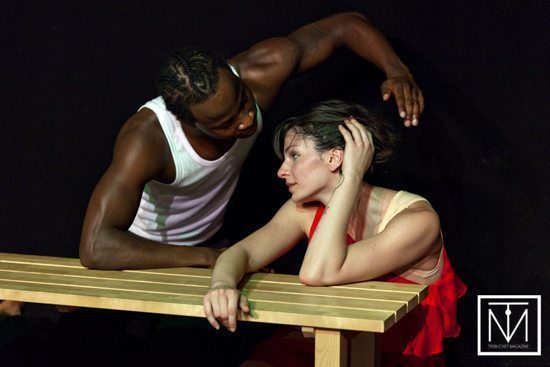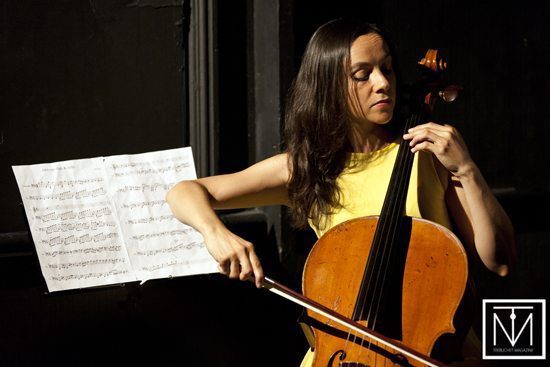The annual Camden Fringe festival, which takes place at various venues in, unsurprisingly, the Camden area, includes plays, comedy and other performance art. I went to see Chrysalis, billed as “a physical theatre piece exploring women’s path in life” by Taragano Theatre at the Etcetera Theatre, which is situated above the Oxford Arms pub on Camden High Street.
The project is the brainchild of choreographer and dancer, Mariana Taragano. It comprises contemporary dance by Mariana and a male dancer, Tunde Olasupo accompanied by a combination of recorded music and live music by flutist, Monica Taragano and cellist, Natalie Rozario.
After a prelude, with Monica dressed a workman and attempting to seduce Natalie with flirtatious flute playing and including an amusing musical conversation between the flute and cello, the piece began with Mariana curled up on the stage wrapped in red cloth. After she had emerged from her cocoon, the two musicians became mother figures and took her in hand, covering her up by wrapping the red cloth around her to form a skirt, putting red socks on her feet and putting her hair into ponytails.
She resisted by taking off the skirt and removing the socks, stuffing one into the armpit of the cellist’s dress, throwing the sheet music to the floor and then trying to eat it in order to stop the musicians from playing, acting as a petulant child but perhaps also as a girl resisting the role laid out for her and the transition into womanhood. I asked Mariana if the red cloth was intended to symbolise the onset of menstruation. She told me that it wasn’t quite that literal but was more as a symbol of femininity.
To the strains of Gershwin’s “I’m Waiting For the Man I Love,” the main character appears to become more confident yet critical of her developing figure, looking herself up and down in an imaginary mirror and then putting on a red dress and dancing a sexy ballroom dance with a non-existent partner, in the style of an insecure adolescent fretting and preening in their bedroom and dreaming of finding a partner.
Shortly after, the male character enters the stage, dressed in a white vest and dark trousers. After some initial flirting, the two dancers perform a romantic pas de deux. Following this he brings on a music stand, both of them lead the cellist onto the stage, sit her down and move her arms into place on the cello and then she starts to play. They bring on a stand for the flutist who also plays and the male embraces the female and wraps her in the red blanket in a protective manner. Stools are also brought onto the stage and arranged around the table, suggesting home making and nest building.
The domestic bliss is short lived however and arguments are signified by fists banged on the table, storming off and the female jumping on the male’s back to attack him. Although Mariana was primarily the choreographer, she told me how Tunde had contributed towards these parts of the piece. Interestingly she would show him in writing the conversation that was being communicated and they would work out the moves together.
After the exit of her now ex-partner, the female reverts to her foetal position on the floor, covered in the red cloth, accompanied by a long and mournful flute solo.
The performance ends with the female back in the dress preening herself but seeming more confident than when she carried out the same activity earlier. Mariana told me later that she wanted the piece to end on an optimistic note, with the female character learning from her experience and, despite the failure of her first relationship, being prepared to go out there and try again.
Indeed, Mariana told me that some of her previous relationships had broken down due her partners’ inability to cope with dance being such a major part of her life but she now has a supportive partner.
[box] what women really want is to find a man and reproduce[/box]
When I asked Mariana about the content of the piece, she told me that she thinks that deep down, what women really want is to find a man and reproduce and that in building society and civilisation, we have lost sight of our basic inclination and that our primary purpose is to reproduce. I was a little surprised to hear such a view from a woman who is obviously talented and cultured, so I probed further.
What about lesbians or women who are infertile or choose not to have children? She was keen to stress that it wasn’t meant in a heterosexist way – she knows lesbian who also have or want children and that we all crave a partner. Despite her previous generalisations, she told me that it was only her perspective; she wasn’t in any way judging women who didn’t want to have children and that maybe dancers, through the physically expressive nature of their work, are more connected with their animal instincts.
Mariana Taragano has a strong technique suggesting a background in classical ballet but she told me that she had in fact studied contemporary dance, although there had been some ballet included in her course. Her movements were confident and fluent. Although at times I felt she could be more flexible in her lower back and abdomen, overall she was a pleasure to watch.
I found Tunde Olasupo slightly disappointing at times. Although he was an expressive dancer, some of his movements lacked precision and strength, making them less dynamic than I would have liked. However there was a strong chemistry between the two dancers, they moved well together and had the crucial ability to read each other physically, which meant that the scenes where they danced together were some of the highlights for me.
Using the musicians to take roles within the story and use their instruments to convey their feelings, rather than merely act as musicians on the sidelines accompanying the dancing, added significantly to the content of the production and achieved the desired effect of having the story told by both the music and the dancers. In addition to being extremely competent musicians, they displayed convincing role playing skills. Having the dancers use sheet music and music stands as props added to the integrated feel of the performance.
During some periods, the two instruments played separately, sometimes as a call and response. At other times they played together with the combination of the deep, soulful tones of the cello and the higher pitched breathy sound of the flute giving the piece an earthy, folk quality, perhaps even pagan like, fitting in perfectly with the mating and fertility theme. During some of the emotionally fraught scenes, their playing was raw and frenzied.
Monica told me that about half of the music played by her and Natalie was by composers, such as Bach. The other half was their own compositions, mainly prepared in advance but sometimes improvised during the actual performances. Despite living in different countries and having to rely on Skype, the musicians worked closely with Mariana in order to share ideas and ensure that the music and dance would fit together. Some essentialists may argue that this co-operative way of working is somehow a “female” approach, but I think this would be short sighted – male film directors such as Ken Loach and Mike Leigh have also employed this technique.
Although the noise from the pub below was not audible, a problem with the Etcetera Theatre is that the t-shirt stall on the pavement outside plays music at some volume. This was a shame as following a particularly emotional flute solo, the chorus of “Pretty Vacant” could be heard and some beautiful cello playing was rudely interrupted by “God Save the Queen” in the background.
[box] it seems that Taragano Theatre is her baby[/box]
Mariana doesn’t yet have any children but in the meantime, it seems that Taragano Theatre is her baby. It is obvious both from watching the production and speaking to her that she is passionate about what she does, both as a dancer and as a choreographer. This is no ego trip however and she told me that she feels fortunate to work with such a talented group of people. Although I may not accept the central premise of Chrysalis, there is no denying that Mariana’s ability to harness the talents of others and use a collaborative approach in choreography and music has resulted in a well expressed piece of performance theatre. She may well be the Carrie Bradshaw of contemporary dance.
Photos: Carl Byron Batson


























Wow! pleasure to read, and well done Mariana! xxx